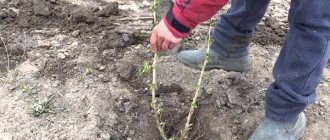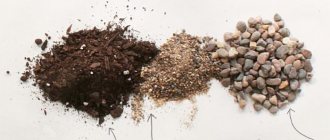When is the best time to replant cacti at home?
There are two opposing points of view regarding when is the best time to replant cacti. Some lovers believe that the best time is the period of active plant growth, that is, the height of spring and the beginning of summer.
The best time to replant cacti is during the winter dormancy period from November to March.
Proponents of spring-summer transplants believe that during this period cacti are most viable and adaptive - the root system develops quickly, the plant actively photosynthesizes and grows.
Therefore, if some caution is observed during subsequent watering (due to possible damage to the roots when replacing the substrate and pot), the procedure should be completely painless.
And although, in general, life experience does not strongly contradict these theses, some amateurs, when asked about when to replant cacti at home, still confidently answer that this should be done in the autumn-winter period.
It is worth briefly dwelling on the advantages of transplanting a cactus from pot to pot in the fall or winter.
- First: cacti are in a state of deep physiological dormancy, so the inevitable loss of part of the root system does not in any way affect the condition of the plants, either at the time of transplantation or later. All processes are slowed down as much as possible, so even the entry of infectious agents into possible wounds on the roots will not lead to their immediate spread throughout the tissues of the wintering plant.
- Second: before transplanting a cactus into another pot, an amateur should not calculate anything, because he is in no way limited in terms of planting, starting from the moment of shaking the plant out of the old container and before moving it to a new one. If it turns out that some component of the soil mixture has run out, the owner of the collection can calmly postpone planting for a time sufficient to purchase or prepare what is needed. The time before replanting a cactus in a pot can be several days or even weeks without significant harm to the replanted plant. The only thing that should be done before replanting the cactus during a delayed procedure is to fix the succulent in a vertical position to avoid caking of the roots, especially if water or fungicide solutions were used to wash them. To do this, just place the plant on a medium-sized pot vertically with the roots down (using a wooden toothpick to straighten the roots after washing).
- Third , in the case of autumn-winter transplantation of cacti at home, there is no need to resort to complex calculations - when to plant, when to water for the first time.
- Fourth , there is an opportunity to actively work with the root system. Remove particularly long roots, make deep pruning for stronger subsequent branching. If necessary, you can wash the entire root system and root collar in order to trim and treat all problem areas with the necessary preparations.
These photos show how to transplant a cactus into another pot:
In the case of autumn-winter transplantation of indoor cacti, you identify and treat sick and “problematic” plants long before the onset of spring. Therefore, by the beginning of the growing season, cacti have time to completely heal the wounds and form waiting roots so that after the first watering they can actively begin to grow.
If you transplant such plants late, you may lose at least a third of the warm season of the year!
Here you can watch a video on how to plant a cactus at home:
In autumn and winter, the root system of plants does not suffer at all from overheating. Therefore, in cold weather, it is easier to replant cacti at home, since during this period no problems or external factors appear that affect the potential development or inhibition of the root system.
And already at the beginning of summer, such a problem may become urgent in some regions, and certain efforts will have to be made (individual shading or a separate cool parking lot) so that the adaptation period of the transplanted plant passes painlessly.
In the next section of the article you will find out which pot is best to plant a cactus in.
How to transplant and plant correctly
To properly plant a cactus, you need to complete all the necessary steps:
- First you need to remove the cactus from the old pot. To avoid getting hurt by the plant's spines, you can use plastic tweezers. There is another way to carefully remove the cactus. You need to wrap the plant in paper several times, after which the pot is turned over and the succulent is carefully pulled out;
- If the cactus is “stuck” in the pot with its roots, you should squeeze the pot from the sides, or separate the soil using a knife along the edges of the pot;
- If the succulent easily came out of the pot, while a significant part of the roots broke off and remained in the ground, then you need to remove the rotten areas on the roots of the cactus. All resulting sections should be treated with crushed charcoal;
- In case of large loss of roots, when replanting the plant, it is necessary to add more river sand to the new soil. It is also noted that the container for the cactus should be chosen smaller than the previous one;
- If it is a group of plants and you need to transplant them, carefully separate the roots of the shoots from each other. You can do this with a stream of water, thereby rinsing the roots from the soil. This will make it easier to separate them without damaging them. After this procedure, be sure to dry the plant.
- Then drainage and a small amount of substrate mixture are poured into a new container;
- Afterwards, very carefully you need to straighten the roots and add soil between them;
- Then the soil is poured. It is worth noting that the soil should be filled only to the root collar.
It is noted that an important aspect in the transplantation process is the stem or root collar, which should not be covered with soil. If the stem is covered with soil, a rotting process occurs, which will lead to the death of the plant.
If you replant a cactus bought in a store, you should carefully shake off the roots from the old soil. Store-bought cacti are usually planted in peat, which is why you need to carefully separate the old soil from the roots of the plant. The soil used for commercial succulents is not suitable for growing cacti. Experienced cactus growers note that it is much easier to get rid of purchased soil if it is dry. And peat is removed by soaking the root ball in warm liquid.
Useful video
How to properly replant a cactus at home: what pot is needed for planting (with video)
Choosing a pot in which to transplant a cactus, despite the seemingly trivial task, is a matter of exceptional importance. And there are at least two reasons for this. First, you choose a container to house the root - an extremely important organ of the plant, through which the cactus absorbs water with dissolved mineral compounds and transports them to the stem.
Also, excess amounts of water are often stored here and chemical compounds important for the life of the plant are synthesized. The second good reason is the need to improve the root system not for 1-2 days, but for several years!
Based on this, it is necessary to provide not only for the pot to correspond to the current state of the root system, but also to certain dynamics of its development during the time allotted until the next transplant.
The key parameters on how to choose a pot to plant a cactus are the upper diameter (section), height and, as a consequence of the first two, useful internal volume.
Less significant, but sometimes also worthy of attention, are the color of the plastic, the ability to transmit sunlight (for white and translucent ones), the presence of a retractable bottom and a slightly conical shape.
Look at the photo on how to choose the right pot to plant a cactus:
Key parameters are vital to assess whether the current state of the root system is appropriate for the pot being selected. The size of the pot should not significantly exceed the root system at the time of transplantation.
Nevertheless, the solution usually represents some kind of compromise, taking into account the fact that very soon the developing root system can significantly and relatively quickly absorb the new volume.
Before transplanting a cactus with a rudimentary root system into a new pot, keep in mind that such plants will most likely have problems absorbing a large volume, in which, after watering, if the substrate is insufficiently drained, excess moisture will be retained for a long time.
At the same time, you cannot choose a small pot for a cactus with a weak root system, but with a large and heavy stem. Such a plant in a small pot can simply tip over.
Species with powerful turnip and radish roots will require tall, narrow pots with significant potential for linear root growth, but do not require a large amount of soil that can bind and retain significant amounts of water for a long time.
The color of pots can also be an important parameter in some cases. Planting plants in black pots may be considered unsuccessful due to possible overheating of the root system if they are exposed to direct sunlight.
However, this problem disappears if the pots are tightly arranged in pallets. Slightly conical containers (round or square in the upper section) are definitely more convenient for transplanting, as are pots with a retractable bottom.
If transplantation is rare or the root system is strongly developed, shaking cacti out of such pots is always accompanied by less trauma to the roots than when using cubic or cylindrical pots.
How to transplant a cactus into another pot is shown in this video:
Further flower care
How to replant aloe: options in another pot and examples at home
After transplantation, the cactus needs special care. This is especially true for the first month of a flower’s stay in a new pot.
Cactus care
Soil and watering
For large flowers with a massive stem, after transplantation you need to install a support (for 2-3 weeks). This will allow the cactus roots to grow more actively. If you follow the transplanting rules, the plant will be able to adapt to the new soil very quickly, and soon the support can be removed.
Important! The cactus should not be watered immediately after transplantation. Within 4-5 days the plant should be allowed to get a little stronger.
Top dressing
It is not advisable to fertilize immediately after replanting the cactus. It is recommended to wait 2-4 weeks and only then begin to fertilize the soil. It should be fed once every 14-15 days (with abundant flowering - once every 10 days). The flower should be fertilized only after watering.
Humidity
To avoid dehydration, the flower should be covered with plastic wrap. This will create increased humidity, in which the plant will be able to feel more comfortable during periods of lack of watering.
Lighting
For normal development, the flower needs good lighting. The cactus is a light-loving plant, so it should be placed on a south-facing window. If this is not possible, then the plant can be placed on a western or eastern windowsill. If the cactus is located in the north, then it is necessary to organize additional lighting for it.
The procedure for transplanting a cactus itself is not as complicated as it seems at first glance. At the same time, it is not necessary to be a professional in this matter, since even a novice gardener can replant.
What other pot can a cactus be planted in: plastic containers for replanting
The era of ceramic pots, one way or another, is coming to an end, and they are being replaced by plastic ones - cheaper, practical to use and convenient in size and shape.
Light shining through the sides of the pot can cause algae to grow on the inside of the plastic. However, in some cases the negative effect of this is not obvious.
Moreover, as mentioned earlier, when testing a new soil composition, you can use transparent plastic (disposable) cups to observe the behavior of the substrate after watering and the development of the root system of experimental plants in it.
A certain convenience of plastic pots with thin walls is their ability to easily deform (stretch). Such deformation-swelling, on the one hand, partly prevents strong caking of the soil and the growing root system due to increased pressure inside the pot, and on the other hand, serves as an indicator that it is time to replant the cactus.
These photos show the best pots for replanting cacti:
Of course, the pot itself is not always the determining factor. As a rule, it “works” together with the substrate. Both the structure and water-retaining features of the latter can partly compensate for possible errors or irrational choice of pot.
So, to reduce the absorptive capacity of a pot with a substrate (large volume), we can completely reduce the absorptive capacity of the substrate itself by including large elements that are inert to absorbing water - for example, coarse gravel or balls of packaging foam.
The correct choice of pot and accompanying substrate for planting cacti at home can always be assessed during a planned or emergency replanting of a cactus, and in case of unsuccessful results, errors can be corrected.
With normal growth of the cactus and its root system, after 2-4 years, as a rule, it is necessary to transplant the plant into a pot of the next size class.
Next, you will find out in which soil is best to replant cacti.
Selecting soil for replanting
Regardless of what type of cactus (mammillaria, gymnocalycium or mix), you need to choose the right soil for the pot. The soil for planting a cactus should be loose, so that air and moisture can easily pass through, but not too loose, for example, like sand.
Be sure to use drainage at the bottom of a large or small pot, which is covered on top with a layer of coarse sand and then with soil mixture.
Before use, it is recommended to steam the soil mixture in a water bath for half an hour.
The planting mixture can be bought ready-made in a store or made with your own hands at home from rotted leaves, peat, washed coarse sand (one part each) and turf soil with crushed red brick (two parts), and you can also take charcoal or old plaster ( one part at a time).
It is not advisable to use clay, since if liquid gets in, it will stick together, after which there will be no flow of moisture and air to the roots. And after the clay dries, it will crack, which can cause the destruction of the roots. It is also not recommended to take fine sand, as it quickly sticks together, forming a dense crust.
How to plant a cactus at home: the right substrate
There are two main views on how to prepare the substrate for planting a cactus. Amateurs and beginners usually believe that there is a certain “magic” composition of the mixture, known to professionals and people with experience, which allows them to successfully grow beautiful and harmoniously developed plants.
They are ready to experiment endlessly, listen to advice and often transfer their small collection from one substrate to another almost every year.
Professionals and amateurs - owners of large collections usually take a completely different approach. The large volumes of mixture required for current activities do not allow them to rush from side to side frivolously.
What is important to them is the ease of purchasing individual soil components for planting cacti, their stable and repeatable quality from year to year, which allows them to build all agricultural technology taking into account the characteristics of a specific substrate in specific conditions.
We can also distinguish an intermediate category of cactus growers who have already been able to fully decide on the optimal substrate for their conditions, but due to the relatively small volumes of its use, they continue to experiment with individual components without fundamental changes in their views on the composition as a whole.
This video explains in detail about replanting cacti:
When preparing soil for replanting cacti, you must understand that this is one of the determining factors for the plants to obtain water. In real life, when watering, water is always divided into that which is absorbed by the roots of the cactus, and that which is lost due to either evaporation through the capillary system or flowing through the drainage holes of the pot.
This balance is, in fact, a subtle tool for adjusting to the conditions of our culture. If the balance shifts towards the accumulation and retention of water, the substrate is less aerated, becomes “swamped” for a long time, and its thermal insulating properties deteriorate.
By shifting the balance towards rapid water loss, we shorten the periods of comfortable water consumption and growth of the root system, creating a general moisture deficit for the planted plant with a corresponding slowdown in growth.
Before planting a cactus at home, you need to understand what the soil should consist of. Potential substrate constituents can be divided into three main groups.
- The first group is conditionally neutral elements, practically inert towards water (in small quantities). For example, coarse river sand, fine and coarse gravel. Typically, these elements are chemically neutral and are designed to maintain the heterogeneity of the soil structure, hinder its caking, and also maximize drainage properties.
- The second group is water-absorbing components. For example, zeolite, some types of calcined clays, perlite, various types of volcanic lavas. These components also perform the functions of draining and loosening the substrate, prevent caking and increase its aeration. In addition, they can provide individual elements of mineral nutrition. But the most important thing is the absorption of water and its gradual, slow release subsequently, which helps the soil maintain high relative humidity for a long time without directly flooding the plant roots with water.
- The third group , which can be used in various proportions, is the actual nutritional elements. These include various types of peat, peat mixtures, as well as natural soils and clays collected in a forest, park or meadow. Typically, these elements are capable of both providing plants with mineral nutrition and, to a certain extent, accumulating water during irrigation. However, water binding occurs in a form that is less useful for the substrate - excessive saturation with water with the loss of such useful aeration.
These photos show how to make a mixture to plant a cactus:
A clear understanding of the physicochemical nature and functions of the main components of the substrate, as well as how they behave individually and in combination, allows for a fairly fine adjustment of the soil system of the collection to the conditions of cacti culture (features of pots, temperature dynamics, minimum and maximum temperatures, frequency of watering and application of mineral fertilizers).
To plant a cactus, each amateur must choose the optimal composition of the substrate for himself - according to his means, if possible, regular replenishment and storage of supplies, according to his own (unique) conditions for growing cacti!
Here you can watch a video of preparing soil for replanting cacti at home:
How to plant a cactus?
Propagation by cuttings is one of the easiest ways to ensure the propagation of a cactus. Only the elastic parts of the plant are suitable for this. However, there are also cases when this propagation method is the only one to save part of the flower. When an adult bush is already dying or sick, it is worth separating the wilted cuttings from it and trying to grow a healthy plant.
Only part of the flower can be cut. The cut should be sharpened and then dried for at least 10 days. Such a cutting is planted in the soil as a “baby”. The process of root formation is similar. You can water the young cut only after two weeks. Before this, rare spraying from a spray bottle is allowed so that only fine water dust falls on the plant. Propagation by seeds is considered the most difficult process. This requires heating and maintaining complete sterility.
What soil to replant the cactus in: mineral soil for planting
Land for planting cacti is not only soil (as we often call various types of natural soils prepared for further sowing in everyday life), but also other components that are not soil in the strict sense of the word.
And since land ceases to be a key component of mixtures, as was observed in the practice of amateur cacti growing 10-20 years ago, then it is quite possible to imagine amateurs seeking to bring the experiment to its logical conclusion, namely, try to cultivate cacti in substrates where soil is completely excluded from the mixture.
Such substrates are usually called mineral, and their use is a trend of recent years. Theoretically, by excluding soil and all its accompanying organic matter from the composition of the planting substrate, we get rid of a large number of problems associated with the potential development of pathogenic microflora (whether bacteria or fungi), especially relevant against the backdrop of possible miscalculations with irrigation and weather forecasts.
At the same time, deep down there remains a suspicion that when using exclusively mineral components, cacti may, to a certain extent, suffer from the inability to obtain accessible mineral nutrition or from its lack.
Proponents of mineral substrates compensate for the latter by more regular fertilizing with weak solutions of mineral fertilizers. To some extent, the mineral substrate and the culture based on it can be considered a transitional stage between traditional culture and classical hydroponics.
What are the prerequisites for using mineral substrates?
You can do a simple experiment. We have two imports in our hands, brought from nature. It is necessary to root them, since the entire peripheral root system was removed when the plants were collected, leaving only the “turnip” or powerful taproot, which by themselves are not capable of absorbing water with dissolved mineral compounds.
We plant one plant in a traditional mixture with a high proportion of soil, and the second in a purely mineral mixture (a mixture of river sand, gravel, perlite, etc., or simply in a beam). After some time, we will see noticeably different results. The first plant has difficulty rooting. The roots appear, then stop growing and rot.
At best, we are faced with an extremely underdeveloped root system, which can hardly be rated higher than “satisfactory.” The second plant, as a rule, does not even always need to be shaken out of the pot to make sure how much the root system has recovered.
Its restoration and work are visible both from the plastic pot, which has become quite bulging from the abundance of roots, and from the way the initially shriveled cactus has filled out and increased in size during rooting.
These photos illustrate how to create a substrate for replanting cacti:
In fairness, the following should be noted. Some colleagues tried to grow plants on monomineral substrates (for example, in pure beam or lava). If we take their experience as a whole, and not for individual species or plants, then the result (not to mention the high cost of this material in Russia!) is rather negative.
Many types of cacti clearly do not like this planting, although perhaps the matter is somewhat different - for monomineral substrates, it is also necessary to adjust the watering and maintenance conditions.
The departure from the traditional “earth” culture of cacti (even a 30-50% land share, as recommended by some modern publications) has significantly enriched amateur practice, making it possible to simplify and make sustainable the root culture of a significant number of species that were traditionally considered quite difficult for amateur cultivation.
Below we describe how to replant cacti not only correctly, but also beautifully.
Preparation for replanting: soil mixture
The soil mixture must be prepared in advance - already two to three weeks before planting the cactus. Prepare your own earthen mixtures for cacti. Basic soil requirements before transplanting a cactus:
- looseness of the earth,
- water permeability, which will ensure good access of oxygen to the roots;
- availability of sufficient nutrients;
- absence of rot and excess nitrogen (which will immediately lead to developmental deviations).
In the literature you can find quite contradictory recommendations for preparing a soil mixture for cacti. This matter is very complicated. Experience accumulates gradually. The composition and properties of even soil types with the same name, but taken in different places, are usually heterogeneous. And the soil requirements for representatives of different types of cacti are not the same. It is worth noting that most types of cacti require acidic soil (pH 4.5-6), but some species require the addition of lime for better development. Calcareous soil is needed when growing hairy cacti and cacti with large spines.
Preparing ideal soil at home will take a lot of time, so many people buy ready-made mixtures for cacti, however, if you want to do everything yourself, here is the recipe.
If you bought a ready-made mixture, go to this part of the article.
The main components when preparing soil mixture for cacti at home:
- turf soil and sand (in a ratio of 2:1),
- leaf soil,
- sand,
- special additives.
The clay-turf part , from which the main supply of nutrients is introduced, is prepared as follows: in the fall or summer, you cut off the turf layer in a fertile area with abundant grass; turn them over with the grass side down and stack them in a heap a meter high. Make a small depression in the center to retain rainwater.
Layer from layer can be separated with a manure pad. This pile needs to be shoveled two or three times a year. In dry weather, spray with water or slurry. After two to three years, the turf land is ready for use.
Leaf humus , which gives the soil looseness and lightness, can also be obtained by collecting rotted leaves in heaps, or you can take rotted soil under trees (just keep in mind that coniferous, oak and willow leaf soil is considered unsuitable for cacti ). Complete rotting of the leaves in the heap is achieved by watering, periodically shoveling and adding (if necessary) slaked lime (at the rate of 0.5 kg per 1 cubic meter of rotted mass). This process will also take 2-3 years.
Sand is absolutely necessary in all soil mixtures for cacti. It does not provide nutrients, but improves soil aeration. Coarse-grained river sand is needed. It is advisable to wash it to remove impurities that weigh down the soil and interfere with aeration. Adding sand to soil mixtures can be in different proportions: from 1/5 to 1/3; and when transplanting cacti with a diseased root system, the amount of sand in the mixture should be increased to half.
Special additives are designed to increase moisture capacity and enhance the development of root hairs. A special additive is prepared from small pieces of tiles or crushed brick. They soften heavy mixtures and serve as drainage. Charcoal, which has a disinfecting effect, will be a valuable addition especially for easily rotting cacti. It is also added to enhance soil looseness. Superphosphate will enrich the mixture with phosphorus.
Now, to obtain an almost universal soil mixture, mix all the components: add a tenth of a specialized additive to equal parts of turf, leaf soil and sand.
There is no need to sift the resulting mixture, but it should be steamed in order to prevent possible fungal and other diseases. To do this, keep the mixture in a thick fabric bag over steam for an hour. After two to three weeks you can transplant your pets.
Before planting in a new place, cacti will not be harmed by a growth-stimulating hot bath for the roots, which is also a means of combating certain pests. Only the roots of the cactus up to the root collar are immersed in water heated to 50-55 degrees for 15 minutes, after which the plant is hung for at least twelve hours to dry.
How to plant cacti beautifully and neatly at home (with photos)
If in life it is not always possible to change the object of adoration for the better, then you can definitely add beauty to cacti, including through beautiful planting. This cannot be neglected. After all, by and large, cacti are no worse than bonsai. And they grow for just as long - decades and even centuries.
Look at the photo on how you can plant cacti beautifully:
The issue of plant formation and maintaining appearance is no less pressing - both at a young age and in adulthood. That is, in essence, we are growing a work of our own agricultural art - after all, each of us at least a little feels like a creator.
A real work of art must have an appropriate design. For a painting this is a carefully selected frame, for a plant - a pot and planting in it. Therefore, before you plant a cactus beautifully, purchase a good container for it.
The best pot for a collection plant is one that is relatively new, clean, and free of chips and scratches. However, it should not be very pretentious. After all, we ultimately want to demonstrate the cactus, and not the peculiarities of our delicate taste?
As you can see in the photo, to plant a cactus, it should be placed in a pot (be it square or round) as precisely in the center as possible:
If the plant is an overgrown clump of asymmetrical shape, you must first estimate the most beautiful options for its placement. Most round and columnar cacti should be planted strictly vertically, without initially tipping in one direction or another.
The plant does not need to be planted too deep or too high - be guided by the best collections of our colleagues or photographs of plants in nature.
This video explains how to replant a cactus at home:
Many pots have an extension at the top, which is not used by most hobbyists as a useful volume. They plant the cactus 1-1.5 cm below the edge of the pot.
- Firstly , at least 10-15% of the useful volume of the pot is lost.
- Secondly , a feeling of sloppiness is visually created. This part of the pot simply needs to be used to fill the top gravel drainage flush with the edge of the pot.
This will not only create the impression of a more neat planting and hide the often not very impressive root collar of the plant (especially an old and battered plant!), but will also not allow unsightly salt deposits to accumulate on the soil surface.
In addition, the presence of a significant-thick layer of upper drainage will make it possible to clearly fix the cactus in a strictly vertical position and give it the opportunity for seasonal movements in the loose surface layer of the substrate: when dry, it wrinkles and goes deeper into the soil, and after watering, it becomes saturated with water and rises slightly.
Some amateurs are afraid to make top powder. With it, they allegedly cannot control the degree to which the soil dries out after watering. However, this problem can be easily corrected by selecting permeable soil and watering less frequently, so it is more far-fetched than actual.
Replanting a cactus
The filling of the pots itself is carried out as follows. The thickness of the expanded clay or gravel drainage layer depends on the size of the pot. Place a thin layer of soil on top of the drainage. Holding the cactus in the center, spread the roots in a circle, then begin filling in the soil.
When the pot is almost full, you need to vigorously tap its sides or press the surface of the substrate with your hand. The remaining top layer of the pot can be filled with decorative crushed stone or expanded clay. This is especially useful for large specimens. For tall plants, after transplantation, fixing supports are placed, which are removed after rooting.
Transplantation also makes it possible to immediately carry out vegetative propagation by separating rooted side shoots (if any) without damaging the roots, and then planting them in separate containers.
Preparing the pot and soil
Choosing the right pot depends on the root system of the cactus. If the plant has long roots, then you can choose a deeper container; if the roots grow around the stem, then it is better to choose a flatter container. In any case, you should not choose a pot for a cactus “for growth”, because The roots of the cactus grow very slowly.
It is important to prepare the pot for planting: wash, disinfect and dry well. The soil should be light and loose, well permeable to water and air. It is useful to add washed and dried river sand.
The soil should not contain a lot of moisture, so expanded clay is placed at the bottom of the pot. It is better not to use old drainage, because... a lot of salts have accumulated in it.
How to increase the number of cacti?
Replanting is an excellent reason to propagate succulents. There are four ways:
- children;
- cuttings;
- vaccination;
- seeds.
Having understood the technique, you can choose the most convenient one.
Shoots and cuttings
The simplest method is to grow cacti with the help of children. They are formed on many species. Their size should be at least 1.5-2 cm, small ones should be allowed to grow. The shoots are separated from the mother plant and transplanted into the soil. For rooting and planting, you should not use nutrient soil. There is a risk of mold and rot. A mixture of leaf soil and sand in a ratio of 1:2 is suitable.
In the absence of children, cuttings are used for propagation. To do this, select only healthy, strong plants, cut off the top part with a sharp knife, dry it for a week and root it in the soil. The sections are sprinkled with crushed activated carbon. Planting material should be stuck into the ground strictly vertically to prevent the appearance of lateral roots on the stem. For fixation, the cutting is tied to a stick.
Seed method
The most difficult thing to propagate a cactus at home is by seeds. This requires sterility, heating, and multiple pickings. The procedure is performed in winter - in January-February. Depending on the size, seed material is sown directly into the ground or pre-germinated.
The method is not very effective, since not all seeds hatch and survive. Sowing is carried out in a container with drainage holes, filled with a substrate with sand and drainage at the bottom. Seedlings are planted in moist soil. Make grooves at a distance of 1.5 cm and place seeds in 1 cm increments. They should lie on the surface and not fall through. Next, the containers are covered with a lid and placed in a warm place for germination.
The period for sprouts to appear is from 3 to 30 days. A month later, the seedlings are planted in the same substrate. When replanting, make small indentations, making sure that the root collar is above the surface. Until the plants reach the desired size, several pickings are carried out. Grown seedlings need to be planted in separate containers.
Grafting
For slow-growing cacti, a grafting method that stimulates their development is more suitable. They grow several times faster. The upper part is called the scion, and the lower part is called the rootstock. Thanks to grafting, it is possible to combine different species. It is important that the lower part has strong roots and is of appropriate size for the scion. Succulents should not be woody or in the growing stage.
The rootstock and scion are cut with a sharp tool, the edges of both are beveled. Before applying, the cut is renewed. The scion is quickly applied to it, matching the cambial rings as much as possible. The upper part is pressed into the lower part so that they are pressed tightly against each other. The connection is secured with plaits, covered with a glass, creating a greenhouse, and placed in a warm place for 2-3 weeks. In the future, they are cared for as for a rootstock.
If children appear, they are removed. When roots grow on the scion, it is separated from the lower part and planted in the ground. A failed vaccination is repeated after 3 months.
Rules of care after transplantation
- It is necessary to protect the transplanted plant from direct sunlight; it is better to place it in partial shade. Optimum air temperature 20-25C
- There is no need to over-moisten the cactus soil.
- You can feed the cactus once a month.
AllaAuthor of the article
Did you like the article?
Share with your friends:
Substrate for cacti
The soil for cacti needs to be loose, not particularly nutritious, but permeable, that is, quickly allowing excess water to pass through. Most cacti require a slightly acidic substrate. From store-bought soils, the best choice would be Substrate for Desert Cacti, but if you can’t find it in a flower shop, then buy Universal substrate, mix it in equal parts with washed coarse-grained river sand and add a little fine gravel to this soil mixture. In the substrate for cacti covered with thick white pubescence or specks - mammillaria, astrophytums, epithelanths - you can add eggshells crushed in a coffee grinder.
Never use soil that has already been used to prepare the soil mixture!
Transfer time
The main question in growing cacti is when to replant the plant. The main sign of health is the elasticity of the needles, rich color, and flowering. It is better to replant a flower that is growing slowly or is beginning to wither immediately to save it from death. Another sign of the need to change the “house” is protruding roots.
The optimal time to transplant a cactus is spring and summer, when active growth occurs. Damage and adaptation to new conditions will be more easily tolerated. This procedure is usually carried out every 2-3 years.











